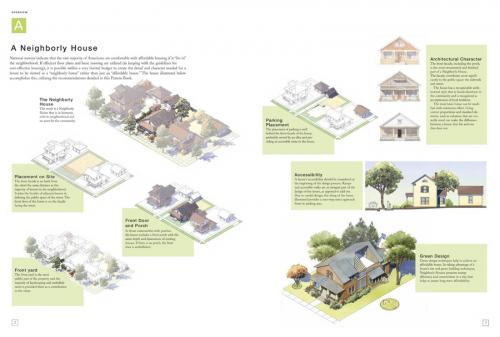
A Pattern Book for Neighborly Houses
Location: Neighborhoods, United States. pattern book
According to national research studies, a large percentage of Americans would accept affordable housing in their neighborhood if it fit in. The goal of this document is to provide a resource for Habitat for Humanity to create houses that are neighborly and will contribute positively to our nation's great neighborhoods, while also playing a constructive role in the creation of desirable new neighborhoods.
The Pattern Book is organized into six sections. An Overview describes the qualities of a neighborly house and suggests a means of adapting basic house types to fit in with neighbors. A Neighborhood Pattern Section introduces the characteristics that make up all neighborhoods, forming patterns and a unique identity for each. A Housing Patterns section introduces House Types, following the idea that different types of housing work in different neighborhoods. An Architectural Patterns section presents guidelines for building houses within a specific architectural vocabulary. A Landscape Pattern section illustrates specific examples of fencing, walls, paving, and garden types found in traditional American neighborhoods. And lastly, an Application section presents illustrated examples of transformations of designs to neighborly houses. This step-by-step process shows how to apply the Pattern Book methodologies to achieve its goal.
Lessons learned: A clear, step-by-step approach to the methodology and approach to creating a neighborly house was going to be an important tool for consensus building, affiliates overwhelming agree that this type of building will, in all likelihood, be a part of the future. As land costs escalate, both affiliates and private developers see the document as an important marketing tool and a vehicle that will serve coordination and harmony of purpose and vision between the two parties.
Transect Zone(s): T3 sub-urban, T4 general, T5 center.
Status: Plan Approved
Guiding Charter Principle(s): Principles 4, 5, 11, 13, 17, 19, 26
Project or Plan's Scale: Block
Features: Affordable/subsidized housing.
Total built area (in sq. ft.):
Total project cost (in local currency):
Retail area (in sq. ft.):
Office area (in sq. ft.):
Industrial area (in sq. ft.):
Number of hotel units:
Number of residential units (include live/work):
Parks & green space (in acres):
Project team designers: Urban Design Associates, LaWuatra Bonci Associates
Project team developers: The Institute of Classical Architecture & Classical America, Habitat for Humanity International
Previous site status:
Starting/Ending date of construction/implementation: -



